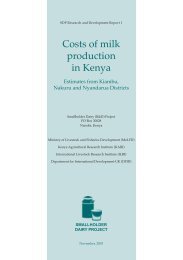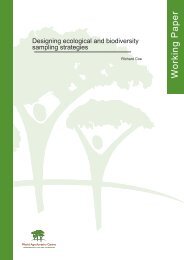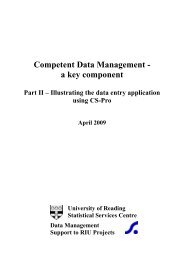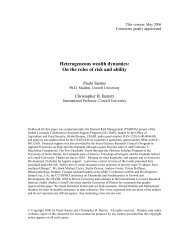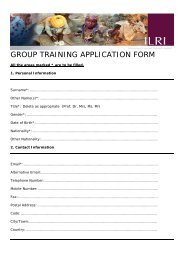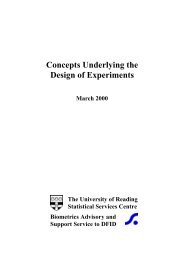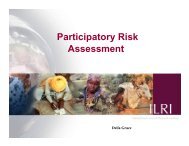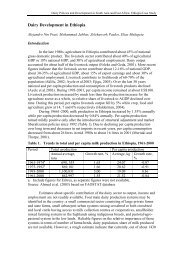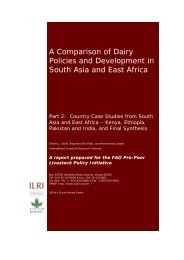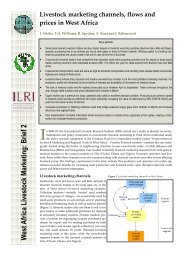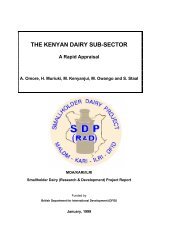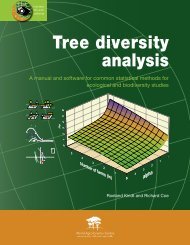Appendix ICambodiaRa<strong>in</strong>fed animal agriculture <strong>in</strong> n<strong>in</strong>e countriesEnvironment and cropp<strong>in</strong>g systemsCambodia is bordered <strong>in</strong> the north by the Lao PDR and Thailand, <strong>in</strong> the west by Thailand, <strong>in</strong> the south by theGulf <strong>of</strong> Thailand and <strong>in</strong> the east by Vietnam. The total area <strong>of</strong> the country is estimated to be about 181,000 km 2 ,about 65% <strong>of</strong> which is forested. The climate is tropical monsoonal and is characterised by a wet season fromMay to November and a dry season from December to April, which has implications for the availability <strong>of</strong> feedresources. Most rice areas receive 1250–1750 mm <strong>of</strong> ra<strong>in</strong>fall annually, but <strong>in</strong> some coastal areas ra<strong>in</strong>fall may beas high as 4000 mm. Ra<strong>in</strong>fall can vary widely from year to year. Dry season crops must rely entirely on irrigationor reta<strong>in</strong>ed soil moisture. Relative humidity varies throughout the year from 60–80%. Temperatures are relativelyconstant, with mean monthly values rang<strong>in</strong>g from 25°C <strong>in</strong> January to about 29°C <strong>in</strong> April.More than 50% <strong>of</strong> the ra<strong>in</strong>fed lowland and upland rice crops are grown on soils <strong>of</strong> low potential. Thesoils are <strong>in</strong>fertile because <strong>of</strong> cont<strong>in</strong>uous cropp<strong>in</strong>g and <strong>in</strong>adequate replacement <strong>of</strong> lost nutrients. Chemicalproperties vary appreciably, depend<strong>in</strong>g on soil type, and the majority <strong>of</strong> soils have poor <strong>in</strong>ternal dra<strong>in</strong>age.The most common soils for the production <strong>of</strong> lowland rice are the ultisols and alfisols. Approximately 1.0million ha out <strong>of</strong> 1.87 million ha are ultisols and alfisols. The pH <strong>of</strong> ultisols ranges from 4.7–5.4, and thesoils conta<strong>in</strong> high levels <strong>of</strong> alum<strong>in</strong>ium. The pH <strong>of</strong> alfisols varies more widely from 4.8–9.4. Levels <strong>of</strong> availablenutrients such as nitrogen and phosphorus are low, and the capacity <strong>of</strong> the soils to hold and exchange cationsis limited. Physical constra<strong>in</strong>ts <strong>in</strong>clude poor structure, poor hydraulic properties and surface crust<strong>in</strong>g.Extensive descriptions <strong>of</strong> Cambodian farm<strong>in</strong>g systems have been made by Delvert (1961) and Tichit(1981). Two ma<strong>in</strong> types <strong>of</strong> farm<strong>in</strong>g systems exist. One is rice-based and the other based on multiple cropp<strong>in</strong>g.Rice-based cropp<strong>in</strong>g systems predom<strong>in</strong>ate <strong>in</strong> Cambodia, and occupy 88% <strong>of</strong> the total cropped land (Nesbitt1996). Rubber and maize are the most important crops after rice. Other secondary crops grown <strong>in</strong>cludemungbean, tobacco, soyabean, cassava, sweet potato and sesame. Vegetable production is important alongthe Mekong River.Rice production systems can vary accord<strong>in</strong>g to the flood<strong>in</strong>g regime, plant<strong>in</strong>g season, level <strong>of</strong> watercontrol, plant<strong>in</strong>g pattern, topography and soil type. Five major rice systems exist <strong>in</strong> Cambodia, but onlyra<strong>in</strong>fed lowland and upland rice are relevant to this study. The former is planted from June to October andharvested from October to December; the latter is planted from April to June and harvested <strong>in</strong> December.Ra<strong>in</strong>fed lowland rice is transplanted and grown on flat land where it is easy to construct bunds. Riceproduction is dom<strong>in</strong>ated by the lowland crop (85.7%) consist<strong>in</strong>g mostly <strong>of</strong> medium- to late-matur<strong>in</strong>g varieties.Some 92% <strong>of</strong> lowland rice is grown <strong>in</strong> the wet season as a s<strong>in</strong>gle crop, with yields averag<strong>in</strong>g 1.3 t/ha. Thearea cultivated per household varies from
or waterlogged <strong>in</strong> the wet season and are, therefore, unsuitable for dry-land crops. In multiple-cropp<strong>in</strong>gsystems rice can be mixed with pearl millet, maize, sesame and cucumber. Any empty spaces are filled withgourds, pumpk<strong>in</strong>, taro, sweet potato and chili. Around the mixed crop area cassava, sweet potato, papaya andbanana may be planted. In other systems, rice may be <strong>in</strong>ter-cropped with maize, cucumber and peanut.With the exception <strong>of</strong> those cropp<strong>in</strong>g systems associated with shift<strong>in</strong>g cultivation, the application <strong>of</strong>some <strong>in</strong>organic fertilisers is practised. However, the average quantity applied nationally is only about 10kg/ha. The advantage <strong>of</strong> us<strong>in</strong>g urea as a nitrogen source is that small quantities can also be used to improvethe nutritive value <strong>of</strong> rice straw for animal feed at no extra cost. Farmers apply manure to the rice nurseriesas there is usually not enough available to apply to the grow<strong>in</strong>g crop, given that farmers only keep three t<strong>of</strong>our animals per household. Currently, about 60–70% <strong>of</strong> the fertiliser needs <strong>of</strong> crops are met by manure fromlarge rum<strong>in</strong>ants. Experiments conducted by IRRI have shown that grow<strong>in</strong>g green-manure crops before ricecan <strong>in</strong>crease rice yields by up to 40%.<strong>Animal</strong> resources<strong>Animal</strong>s contributed about 13.2% <strong>of</strong> real GDP <strong>in</strong> 1994, and the total value <strong>of</strong> animal production is about US$180–200 million (FAO 1994b). <strong>Animal</strong>s provide food (meat and eggs), cash <strong>in</strong>come (about 30–40% <strong>of</strong> totalfarm <strong>in</strong>come), and <strong>in</strong>surance aga<strong>in</strong>st risk as well as benefit<strong>in</strong>g crop production.The animal resources <strong>in</strong>clude cattle, buffaloes, pigs, poultry and ducks. In 1995, there were 2.6 millioncattle, 0.9 million buffaloes, 2.2 million pigs and 10.8 million chicken and ducks. Currently, these are grow<strong>in</strong>gannually at rates <strong>of</strong> 6.8, 3.9, 8.5 and 7.3%, respectively. Given the fact that the animal base was devastatedby the war from 1975 to 1979, the annual growth rates are impressive. The areas <strong>of</strong> <strong>in</strong>tensive cultivation arethe areas <strong>of</strong> highest cattle and pig populations.The order <strong>of</strong> importance <strong>of</strong> the species is cattle and buffaloes, followed by pigs and poultry. Goats arekept only <strong>in</strong> small numbers by Moslems <strong>in</strong> peri-urban areas. The large rum<strong>in</strong>ants are important for meat anddraft power. Buffaloes are used for land preparation on heavy soils. Only male cattle are used for traction,but <strong>in</strong> the case <strong>of</strong> buffaloes, both males and females are used until slaughter at 12 years <strong>of</strong> age. Farmers’dependence on large rum<strong>in</strong>ants for draft power is considerable because <strong>of</strong> their poverty status and the lack<strong>of</strong> access to credit for the purchase <strong>of</strong> small tractors. Some 1.2 million cattle and 520,000 buffaloes provide90% <strong>of</strong> the draft power <strong>in</strong> Cambodia, equivalent to US$ 60–80 million annually. However, the numbers <strong>of</strong>draft animals are limited because <strong>of</strong> the illicit trade <strong>in</strong> live animals with Thailand. Some 30% <strong>of</strong> the farmersdo not own animals and have to hire them for land preparation. Milk production is <strong>in</strong> its <strong>in</strong>fancy, but is likelyto become more important <strong>in</strong> future with improvements <strong>in</strong> the liv<strong>in</strong>g standards <strong>of</strong> the people and theopen-market policy. Non-rum<strong>in</strong>ants are also important, with pigs raised for pork production and <strong>in</strong>comegeneration, and chicken and ducks for eggs and meat. Pork is the preferred meat <strong>in</strong> both the rural and urbanareas. The pig population shows evidence <strong>of</strong> upgrad<strong>in</strong>g through the use <strong>of</strong> improved European breeds suchas the large white.The government has a 350 ha National Cattle Breed<strong>in</strong>g Station at Phnom Tamao where Bos <strong>in</strong>dicusblood from Brahman and Haryana cattle is be<strong>in</strong>g <strong>in</strong>troduced <strong>in</strong>to local breeds. The size <strong>of</strong> the former breedis be<strong>in</strong>g comb<strong>in</strong>ed for draft purposes with the height, speed and greater hard<strong>in</strong>ess <strong>of</strong> the latter. Thecrossbreed<strong>in</strong>g programme, however, lacks a clear plan.<strong>Animal</strong> production systemsThe animal production systems are ma<strong>in</strong>ly extensive. Tether<strong>in</strong>g <strong>of</strong> animals <strong>in</strong> the field or close to thehomestead is practised widely to collect dung for crop cultivation. More <strong>in</strong>tensive systems <strong>of</strong> rum<strong>in</strong>antproduction <strong>in</strong>volv<strong>in</strong>g stall-feed<strong>in</strong>g are uncommon. Pigs and poultry are fed with vegetable residues, kitchenwaste, and limited amounts <strong>of</strong> purchased concentrates, but there is little or no <strong>in</strong>vestment <strong>in</strong> hous<strong>in</strong>g. Pigsare slaughtered at 10–12 months <strong>of</strong> age at weights <strong>of</strong> about 60–70 kg. Although poultry production is basedessentially on scavenger flocks, small-scale commercial production is <strong>in</strong>creas<strong>in</strong>g steadily. <strong>Production</strong> <strong>in</strong> thesemore <strong>in</strong>tensive systems is based on home-mixed feeds. Egg production from improved breeds is about140–170 <strong>in</strong> two lay<strong>in</strong>g-periods, compared to about 60–70 eggs/year for native birds. There are no specialised
- Page 2 and 3:
Affiliation of Authors:Dr C. Devend
- Page 4 and 5:
6.Strategyfor researchJustification
- Page 7 and 8: AcknowledgementsThe International L
- Page 9 and 10: esearch opportunities appropriate t
- Page 11 and 12: Table 1.Animal populations and meat
- Page 13 and 14: Introduction2. Characterisation and
- Page 15 and 16: Figure 2. Sub-humid tropics and sub
- Page 17 and 18: Table 3.Human and animal population
- Page 19 and 20: Table 5. Rice-growing environments
- Page 21 and 22: Multiple upland annual crop systems
- Page 23 and 24: Table 6. Continued.Country Importan
- Page 25 and 26: It should be noted that, compared w
- Page 27 and 28: Table 8.CountryCambodiaChinaIndones
- Page 29 and 30: of non-renewable fossil fuels and t
- Page 31 and 32: Overview of researchThere was a sur
- Page 33 and 34: • Identification of alternative c
- Page 35 and 36: Various animal production systems t
- Page 37 and 38: Presently, much of the vegetable pr
- Page 39 and 40: Table 10. Summary of the main socio
- Page 41 and 42: Table 11. Institutions and organisa
- Page 43 and 44: 3. In the ASEAN sub-region, inadequ
- Page 45 and 46: Table 12. Continued.SituationsPract
- Page 47 and 48: 6. Strategy for researchJustificati
- Page 49 and 50: Table 13. Priorities for research a
- Page 51 and 52: VietnamResearch capacity in NARS is
- Page 53 and 54: CRIFC (Central Research Institute f
- Page 55 and 56: IAS. 1995. Proceedings of the Works
- Page 57: Systems of sub-Saharan Africa. Volu
- Page 61 and 62: Table A1. Important diseases of ani
- Page 63 and 64: • Increased cropping intensities,
- Page 65 and 66: the animal output came from pigs al
- Page 67 and 68: 18-21° North, with an average rain
- Page 69 and 70: In the Nusa Tenggara islands, signi
- Page 71 and 72: Women work 11.5 h/day on average co
- Page 73 and 74: Various Australian forage projects
- Page 75 and 76: village production systems; to stud
- Page 77 and 78: The availability of feed in rubber
- Page 79 and 80: of the Ayeyarwady and Sittang river
- Page 81 and 82: Constraints and opportunitiesInadeq
- Page 83 and 84: gaining in importance, and signific
- Page 85 and 86: Table A3. Characterisation of crop-
- Page 87 and 88: Table A4. Interventions in crop-ani
- Page 89 and 90: Table A4. Continued.Project TitleGo
- Page 91 and 92: otations are practised, and there a
- Page 93 and 94: such as abortion. Vaccination cover
- Page 95 and 96: large areas of forests (3.4 million
- Page 97 and 98: Table A6. Some animal diseases repo
- Page 99 and 100: Appendix IIItineraryThe Philippines
- Page 101 and 102: 26 November 1996 am Visit to small
- Page 103 and 104: Appendix IIIList of persons metPhil
- Page 105 and 106: Mr Chhiv Nan, Acting Director, Depa
- Page 107 and 108: Dr U Maung Ngint, Managing Director
- Page 109:
List of acronymsAARDACIARADBAEZAIBP



